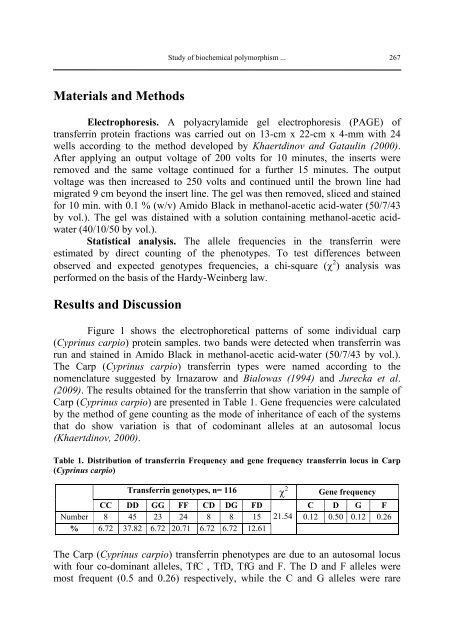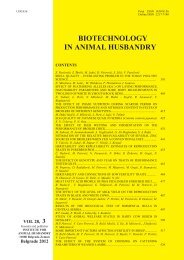Biotechnology in Animal Husbandry - Institut za Stočarstvo
Biotechnology in Animal Husbandry - Institut za Stočarstvo
Biotechnology in Animal Husbandry - Institut za Stočarstvo
Create successful ePaper yourself
Turn your PDF publications into a flip-book with our unique Google optimized e-Paper software.
Materials and Methods<br />
Study of biochemical polymorphism ...<br />
Electrophoresis. A polyacrylamide gel electrophoresis (PAGE) of<br />
transferr<strong>in</strong> prote<strong>in</strong> fractions was carried out on 13-cm x 22-cm x 4-mm with 24<br />
wells accord<strong>in</strong>g to the method developed by Khaertd<strong>in</strong>ov and Gataul<strong>in</strong> (2000).<br />
After apply<strong>in</strong>g an output voltage of 200 volts for 10 m<strong>in</strong>utes, the <strong>in</strong>serts were<br />
removed and the same voltage cont<strong>in</strong>ued for a further 15 m<strong>in</strong>utes. The output<br />
voltage was then <strong>in</strong>creased to 250 volts and cont<strong>in</strong>ued until the brown l<strong>in</strong>e had<br />
migrated 9 cm beyond the <strong>in</strong>sert l<strong>in</strong>e. The gel was then removed, sliced and sta<strong>in</strong>ed<br />
for 10 m<strong>in</strong>. with 0.1 % (w/v) Amido Black <strong>in</strong> methanol-acetic acid-water (50/7/43<br />
by vol.). The gel was dista<strong>in</strong>ed with a solution conta<strong>in</strong><strong>in</strong>g methanol-acetic acidwater<br />
(40/10/50 by vol.).<br />
Statistical analysis. The allele frequencies <strong>in</strong> the transferr<strong>in</strong> were<br />
estimated by direct count<strong>in</strong>g of the phenotypes. To test differences between<br />
observed and expected genotypes frequencies, a chi-square (χ 2 ) analysis was<br />
performed on the basis of the Hardy-We<strong>in</strong>berg law.<br />
Results and Discussion<br />
Figure 1 shows the electrophoretical patterns of some <strong>in</strong>dividual carp<br />
(Cypr<strong>in</strong>us carpio) prote<strong>in</strong> samples. two bands were detected when transferr<strong>in</strong> was<br />
run and sta<strong>in</strong>ed <strong>in</strong> Amido Black <strong>in</strong> methanol-acetic acid-water (50/7/43 by vol.).<br />
The Carp (Cypr<strong>in</strong>us carpio) transferr<strong>in</strong> types were named accord<strong>in</strong>g to the<br />
nomenclature suggested by Irna<strong>za</strong>row and Bialowas (1994) and Jurecka et al.<br />
(2009). The results obta<strong>in</strong>ed for the transferr<strong>in</strong> that show variation <strong>in</strong> the sample of<br />
Carp (Cypr<strong>in</strong>us carpio) are presented <strong>in</strong> Table 1. Gene frequencies were calculated<br />
by the method of gene count<strong>in</strong>g as the mode of <strong>in</strong>heritance of each of the systems<br />
that do show variation is that of codom<strong>in</strong>ant alleles at an autosomal locus<br />
(Khaertd<strong>in</strong>ov, 2000).<br />
Table 1. Distribution of transferr<strong>in</strong> Frequency and gene frequency transferr<strong>in</strong> locus <strong>in</strong> Carp<br />
(Cypr<strong>in</strong>us carpio)<br />
Transferr<strong>in</strong> genotypes, n= 116 χ 2 Gene frequency<br />
CC DD GG FF CD DG FD C D G F<br />
Number 8 45 23 24 8 8 15 21.54 0.12 0.50 0.12 0.26<br />
% 6.72 37.82 6.72 20.71 6.72 6.72 12.61<br />
The Carp (Cypr<strong>in</strong>us carpio) transferr<strong>in</strong> phenotypes are due to an autosomal locus<br />
with four co-dom<strong>in</strong>ant alleles, TfC , TfD, TfG and F. The D and F alleles were<br />
most frequent (0.5 and 0.26) respectively, while the C and G alleles were rare<br />
267




